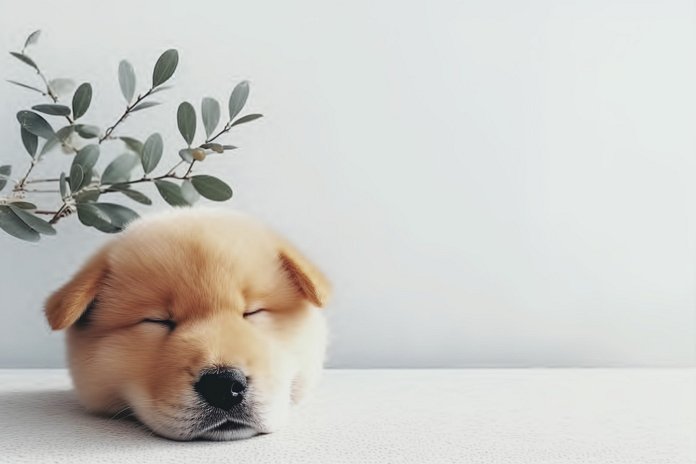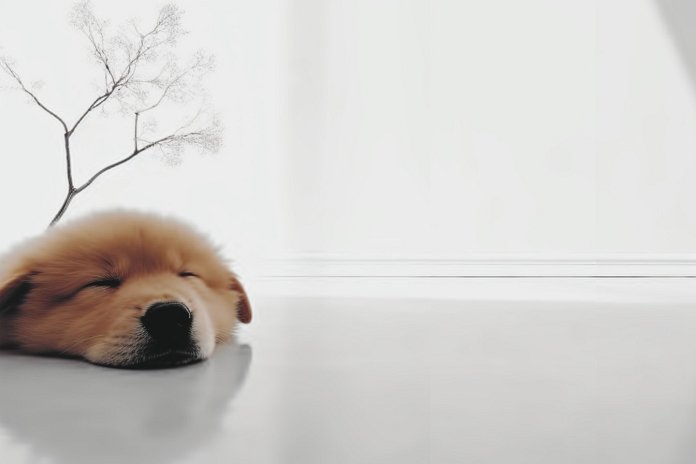
The Chabrador dog is a mix of the Labrador Retriever and the Chow Chow. The Labrador Retriever is known for its skills in hunting and retrieving, while the Chow Chow has a history as a protective guard dog in China. The resulting Chabrador is often a loyal and friendly companion that is suitable for families and can also serve as a reliable guard dog. Compared to its Labrador Retriever parent, the Chabrador generally requires less exercise and grooming, and has moderate needs in both areas.
It’s important to note that the characteristics of crossbred dogs can vary widely, and some Chabradors may exhibit less desirable traits such as aggression, hyperactivity, or aloofness.
Below, we look at Chabrador dog breed, its history, personality, pros and cons of owning an Chabrador, characteristics, and must-see facts. We will also examine how to care for this breed and more. Prepare for a tail-wagging adventure into the world of Chabradors!
| Dog Breed | Chabrador |
| Size | Large |
| Weight | 50-75 lbs (average) |
| Height | 20-23″ (average) |
| Location | Unknown |
| Ancestry | Chow Chow, Labrador Retriever |
| Date of Origin | Unknown |
| Group | Companion, Guard Dog |
| Life Expectancy | 10-12 years |
| Price | $400 – $1000 |
| Family | Canidae |
| Scientific Name | Canis Lupus Familiaris |
📖 Breed History
The Chabrador is a designer breed dog that is a mix between a Chow Chow and a Labrador Retriever. The Chow Chow is an ancient breed from Asia, with their origins believed to be in China, Siberia, or Mongolia. They were used as temple guards and hunting dogs, known for their scenting and pointing skills. They were introduced to England in the late 1700s and became popular in both England and the United States throughout the 1800s and early 1900s. The Labrador Retriever, although not as ancient as the Chow Chow, has a history that dates back to the 16th century. The Labrador’s earliest ancestor is the St. John’s dog, a water dog that worked alongside fishermen in Newfoundland. These dogs were skilled at retrieving nets, ropes, and fish from the water. In the 1800s, James Harris and Walter Scott bred their St. John’s dogs to create gun dogs for retrieving fowl. The resulting canines were the ancestors of today’s Labrador Retrievers. The Chabrador is known to be calmer than a Labrador Retriever and more outgoing and friendly than a Chow Chow, although each dog has its own individual personality.

🐕 Chabrador Appearance
The Chabrador is a medium to large-sized, athletic dog with a sturdy build. They may or may not have the distinguishing blue-black tongue of the Chow Chow. They have a large, flat head with almond-shaped eyes that can be any hue, from hazel to dark brown. The Chabrador’s ears can differ from dog to dog; some dogs favor the Chow gene pool and have triangular ears kept straight, while others have long, rounded ears that droop down from the sides of the head like Labradors. While white patches on the breast and sporadically on the feet are possible, their double-layer coats are normally solid in color. Although their fur is incredibly dense and protects them from the elements on both sides, the outer layers can vary greatly in length, texture, and appearance. Hard, straight hairs will make up the outer layer, however they might be short or medium in length, have a rough or silky texture, and even lay flat against the body or stand straight out from it. Some of these hybrids may even have feathering on their feet and tails, as well as a ruff around their necks.
| 👀 Eye Color | Varies |
| 🐽 Nose Color | N/A |
| 🐕 Coat Color | Ranges |
⚡ Fun Fact: Chabrador dogs need for social interaction is average. This breed likes being around people or other animals, but they don’t mind being left alone for a few hours either.
🐶 Traits & Temperament of Chabrador
The Chabrador is often a calm, amiable dog that loves to cuddle with the family but also makes a wonderful watch dog. Although they may be a little more hesitant with strangers than the typical Labrador Retriever and may have a propensity to pursue small animals, they tend to be patient with youngsters and other canines. However, a crossbreed like the Chabrador can acquire characteristics from either side of their family tree, and in certain situations, these animals may have a tendency towards hyperactivity, aloofness, or even violence. These dogs are clever, and the majority can be trained easily. However, because Chow Chows are known for being independent, certain Chabradors could be a little more difficult in that regard. Early, appropriate socializing will help bring out the best in this dog. To prevent this animal from getting bored and destructive, training should begin at a young age, and there should be lots of mental stimulation offered.
🤝 Are Chabradors Friendly or Aggressive?
Chabrador dogs thrive as the sole pet in a family and may not be the most comfortable with strangers. However, they are known to be friendly towards children, making them a suitable choice for families with kids. On the other hand, Chabradors may not get along well with cats or other dogs, and if you are looking to have multiple dogs or join dog meetups, this breed may not be the best fit. Chabradors are often recommended for elderly individuals, as they can provide companionship and support to older people.
This breed is known for being:
- Active
- Energetic
- Social
- Trainable
- Hunting
- Guarding
- Smart
🐩 Chabrador Care & Maintenance
Chow Chow dogs need bathing at least once a month and occasionally as frequently as once per week, but Labrador Retrievers only need bathing every few months or when they get muddy from their activity. Most Chabradors will benefit from a monthly bathing routine, unless their activities necessitate extra baths. Few times a week throughout the year, and daily during the change of seasons, when these dogs shed significantly, were necessary to thoroughly brush their thick coat on a regular basis to reduce shedding. Particularly if the dog has the hanging type of ear, it is crucial to make sure the ears are cleaned and dried regularly to prevent infection.
Chabrador dogs are known to shed more than the average dog. This shedding is a natural part of their hair growth cycle and varies in amount and frequency based on the dog’s health and breed. If you prefer to avoid frequent vacuuming, you may want to think twice about getting a Chabrador puppy. Additionally, Chabradors typically require bathing every 3-4 weeks. ”
🍖 Food: We recommend few cups daily, costing you about $0.49 – $1.49 daily, or roughly $30.00 a month.
🐾 Exercise: Chabrador dogs have an average exercise need. This breed is satisfied with short walks every weekday and a long ones on weekends.
This dog breed requires to be walked for roughly few miles per week, which equates to about 15 – 35 minutes of physical activity daily. This consistent moderate exercise regimen will help maintain their physical wellness and significantly contribute to their mental stimulation. Consciously setting aside this time for your furry friend can dramatically enhance their life quality, helping them stay energetic, healthy, and mentally alert.
Did you know: Chabrador dogs have an average energy level, so if you live a semi-active life, this breed can be a good choice for you.
❤️🩹 Chabrador Health & Issues
Some of the major concerns for Chabrador Dog Breed can be:
- Patellar Luxation
- Hip Dysplasia
- Cerebellar Abiotrophy
While minor concerns include:
- Cataracts
- Diabetes
- Wobbler’s Syndrome
- Corneal Dystrophy
🤧 Important: Is Chabrador hypoallergenic? Yes.
✨ Bonus: Check out cool, creative, and funny names for Chabrador.
⚡ Chabrador Dog Breed Facts
What makes the Chabrador a great choice for families with young children?
The Chabrador is a great choice for families with young children because they are typically friendly and even-tempered, making them tolerant and patient with kids.
Is the Chabrador breed considered a suitable breed for apartment living?
The Chabrador breed can be suitable for apartment living as they have moderate exercise needs and are generally adaptable to different living environments. However, they still require regular exercise and mental stimulation.
How much exercise does a Chabrador require compared to other breeds?
Compared to other breeds, the Chabrador requires less exercise than the Labrador Retriever parent breed but still needs regular physical activity to stay healthy and happy.
Is the Chabrador breed known for being good with other pets?
The Chabrador breed is generally good with other pets, including dogs, but may have a tendency to chase small animals due to their retrieving instincts.
What are other low-maintenance dog breeds similar to the Chabrador?
Some low-maintenance dog breeds similar to the Chabrador include the Cavalier King Charles Spaniel, Bichon Frise, and Boston Terrier.
What are the common health issues that Chabradors are prone to?
Common health issues that Chabradors are prone to include hip dysplasia, elbow dysplasia, eye problems (such as progressive retinal atrophy), and allergies.
Are Chabradors known to be easy to train compared to other breeds?
Chabradors are generally intelligent and trainable, but their trainability may vary depending on the individual dog’s inherited traits. Some Chabradors may be a little more challenging to train due to the independent nature inherited from the Chow Chow parent breed.
Are Chabradors more prone to separation anxiety compared to other breeds?
Chabradors, like many other breeds, can experience separation anxiety if not properly trained and socialized. However, this can vary from dog to dog.
Are there any dog breeds similar to the Chabrador that are suitable for people with allergies?
Some dog breeds similar to the Chabrador that are suitable for people with allergies include the Poodle, Portuguese Water Dog, and Bichon Frise, as they are hypoallergenic or have minimal shedding.
What sizes of dogs similar to the Chabrador are best for individuals or families with limited space?
Dog sizes similar to the Chabrador that are best for individuals or families with limited space include smaller breeds like the Cavalier King Charles Spaniel, French Bulldog, and Cocker Spaniel.
Is the Chabrador breed known to be good with children with special needs?
The Chabrador breed is generally known to be good with children, including those with special needs. However, proper supervision and socialization are always important when introducing any dog to children.
How does the grooming and shedding needs of the Chabrador?
The grooming and shedding needs of the Chabrador are typically moderate. They require regular brushing to keep their coat healthy and may shed moderately. However, their grooming needs are generally less than that of the Chow Chow parent breed.
We use reliable and publicly available data and resources such as AKC and American Canine Registry to ensure that Chabrador dog breed information is accurate and up to date. If you spot an error, please don’t hesitate to bring it to our attention.